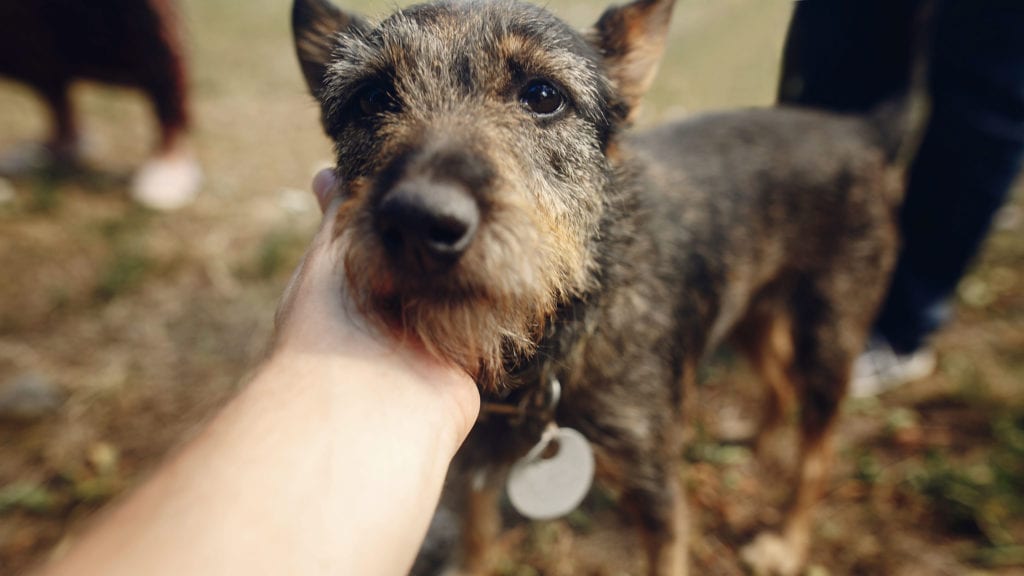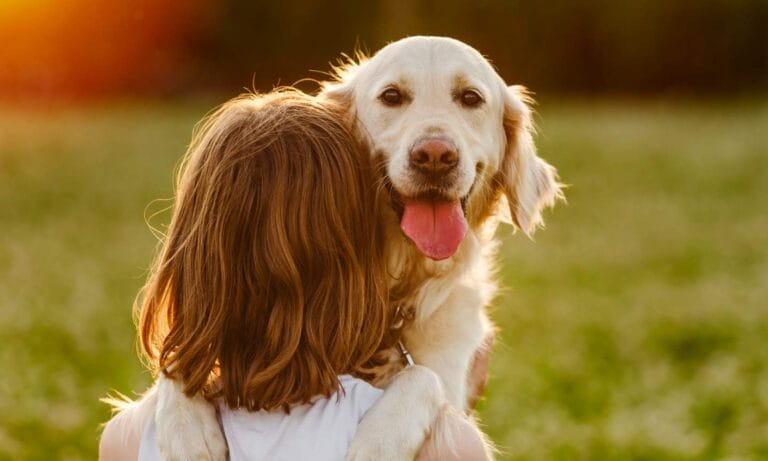You’ve found a lost dog—now what? If you’re unsure what to do if you find a lost dog, you’ve come to the right place. Approximately 10 million pets go missing each year, according to American Humane. So, the chances of you encountering a lost pet are, unfortunately, fairly high. Helping a found dog get back home can be a joyous experience, but it also can be intimidating if you’re unsure of what to do. Here are some tips for what to do if you find a lost dog and how you can help get them home safely.
How to Approach a Lost Dog
If you found a lost dog, approach them slowly and gauge their behavior. “Dogs, especially, often read direct eye contact and facing them directly with your body as a threat,” says Ruthie Jesus, field operations supervisor for the Arizona Humane Society, whose team is responsible for rescuing sick, injured or abused animals. “If the dog is exhibiting friendly behavior and you feel safe, then crouch down to their level and turn your body slightly sidewise to communicate a more friendly intent.” Speak in a friendly, high-pitched voice to keep the found dog’s attention, and remove any sunglasses or hats while interacting, because these can be perceived as threatening to the dog. If you have dog treats handy, use one to try coaxing the dog to come to you.
What If the Lost Dog Is Injured?
If you found a lost dog who is struggling to stand or is severely injured, contact your local municipal shelter. Jesus says that even the friendliest dog may bite as a response to the pain they're feeling, so it’s best left for professionals. They also are equipped to get the dog immediate veterinary care, if needed.
What If the Lost Dog Is on a Busy Road?
If you find a dog along a busy highway or interstate, contact your state’s Department of Transportation, Jesus says. Stopping your car suddenly or exiting your vehicle to coax the dog to you can put you and the dog at risk of an automobile accident. If you find the dog along a neighborhood street, call your local municipal shelter or animal control agency.
Should I Put the Found Dog in My Vehicle?
If you can coax the dog to you and they're responding to you in a positive manner, you may be able to get the found dog help faster if you can drive them to a shelter or veterinarian yourself. But use caution. “Please be cautious,” Jesus says. “If you have to force the dog into your car, they may panic and cause a serious hazard while you’re driving.” You should place the lost dog in the back of your vehicle, according to Jesus. If possible, she recommends creating a barrier between the two of you so the dog can’t jump in the front seat and distract you. Jesus also recommends leaving the windows up to keep the found dog from jumping out while you’re driving. Dogs, especially those who feel threatened, have been known to leap from moving vehicles. Avoid buckling the dog in with the seatbelt, Jesus says. While your intention is safety, Jesus warns that the dog can become entangled and injure themselves. Drive slow as safety allows, and avoid slamming on your breaks.
Should I Take the Found Dog Home With Me?
If the dog isn’t injured and you’re comfortable caring for them until you can reunite them with their pet parent, bringing them home with you is certainly an option. “I would recommend keeping the dog away from your own pets for several days to avoid illness or disease,” Jesus says. If possible, exercise the dog or walk on them on a dog leash before bringing them into your house. This will relieve anxiety and allow them to go potty. Secure the found dog in a laundry room, bathroom or other room with a door, or use a pet gate. Remove or secure any items they can chew or that might injure them, such as electrical cords, decorations and other household items. (Follow our guide on dog-proofing to make sure you haven't missed anything.) Provide them with dog food, water and other essentials until you can return them to their home.
How to Locate the Pet Parent
Once the found dog is safe and secure, you can start the process of locating their family. If the dog is wearing an identification tag, you can start by calling the number on it. If they don't have tags, you can take them to a veterinary office, where they can scan the pet for a microchip. “Microchipping can significantly increase the likelihood of a reunion (with a lost pet),” says Dr. Kirk Breuninger, VMD, MPH, DACVPM, senior manager of veterinary field support at Banfield Pet Hospital in Vancouver, Washington. Reach out to your local shelter or humane society as well; they are the best resource for lost and found dog cases. They can let you know if anyone has come to their facilities inquiring about a dog matching your particular case and help you if the pet parent cannot be located. You can also post “found dog” fliers and messages on social media as well as other online outlets.
Read More
- Here’s How You Can Help Stray and Feral Cats in Your Community
- How Dog Lover Maria Ducasse Created a Community to Keep Pets and Their Parents Together
- Why I Decided to Rescue a “Sato” Dog from Puerto Rico (and Why You Should Too)
- What Is a Pet Microchip? Here’s How Microchipping Your Pet Can Save Their Life
- Dog Zodiac Signs: What Your Dogs’ Astrology Signs Says About Their Personality
Share:











